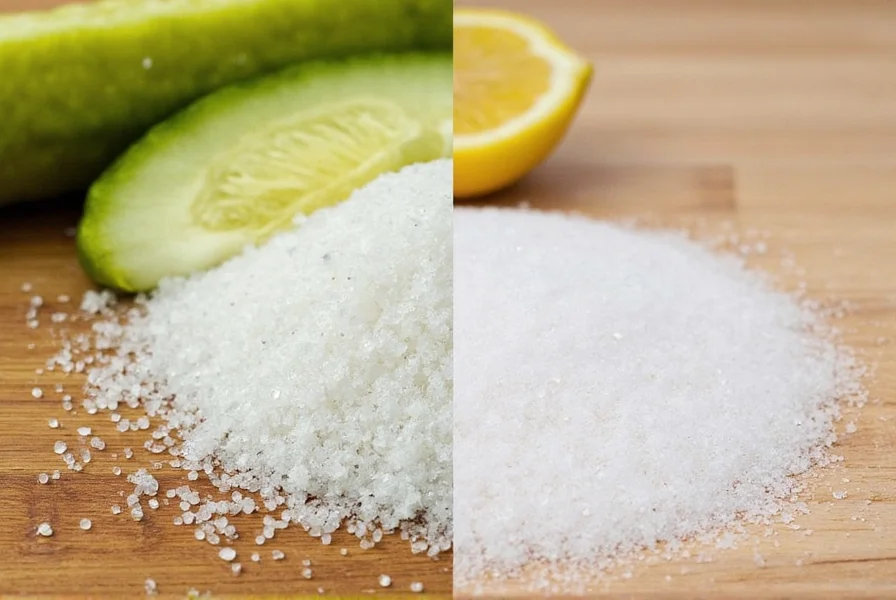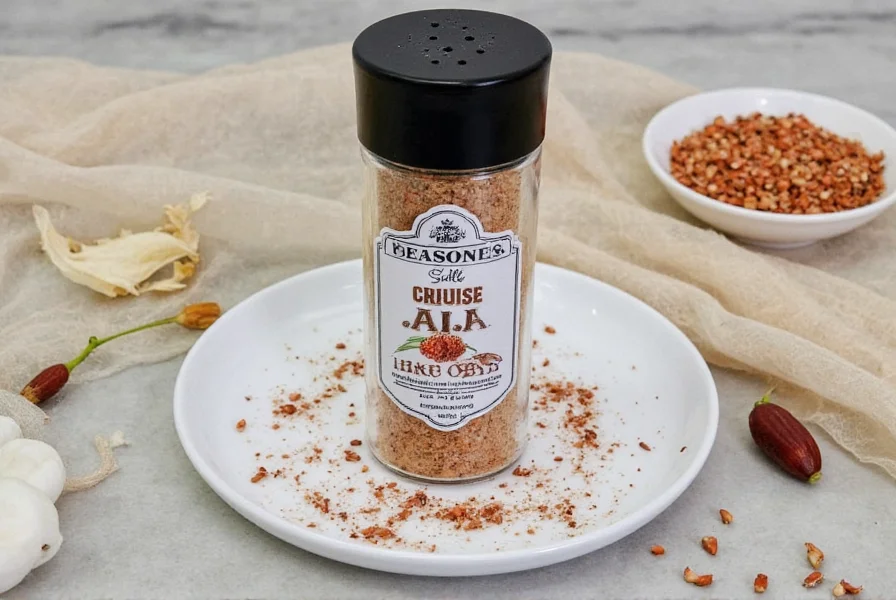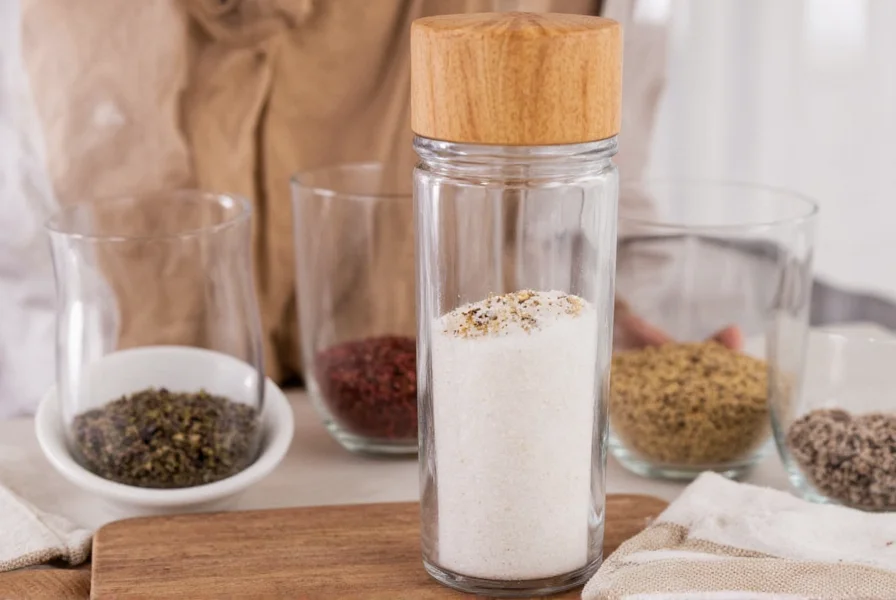What's in Seasoned Salt? Key Ingredients Explained
Seasoned salt is a versatile spice blend that combines salt with various spices to enhance flavor in cooking. The primary ingredients typically include salt, garlic powder, onion powder, paprika, black pepper, and celery seed. Some commercial blends may also contain dried herbs like thyme or oregano, or additional spices such as cumin or chili powder.
What Exactly is Seasoned Salt?
At its core, seasoned salt is simply table salt mixed with other spices and flavoring agents. It's designed to offer a one-stop seasoning solution without needing to open multiple spice jars. Think of it as convenience meeting complexity — a sprinkle of this can replace a dash of garlic powder, paprika, onion powder, and more.

While the exact blend varies by brand and intended use, most seasoned salts combine salt with a few common flavor-enhancing ingredients.
The Usual Suspects: Common Ingredients in Seasoned Salt
Let's take a closer look at what typically goes into seasoned salt:
- Salt (Sodium Chloride) – The base of any seasoned salt blend, usually fine iodized or sea salt.
- Garlic Powder – Adds a savory depth and aromatic kick.
- Onion Powder – Brings sweetness and umami to balance the saltiness.
- Paprika – Offers mild heat and color; smoked paprika adds a smoky note.
- Black Pepper – Provides a bit of bite and enhances overall flavor layers.
- Dried Herbs – Thyme, oregano, parsley, or rosemary might be added depending on the blend.
- Celery Seed or Celery Salt – For an earthy, slightly bitter undertone.
- Spices like Turmeric or Chili Powder – Found in some ethnic or specialty blends.
Some blends may also include anti-caking agents like calcium silicate or even monosodium glutamate (MSG) for enhanced savoriness.
| Ingredient | Flavor Contribution | Common Usage | Variations |
|---|---|---|---|
| Salt | Base seasoning, enhances all flavors | Universal in all savory cooking | Iodized, Sea Salt, Kosher |
| Garlic Powder | Pungent, savory, aromatic | Meats, sauces, roasted veggies | Granulated Garlic, Garlic Salt |
| Onion Powder | Sweet, umami-rich, pungent | Soups, stews, grilled meats | Onion Flakes, Onion Salt |
| Paprika | Mild heat, sweet, smoky (if smoked) | Chili, eggs, deviled dishes | Sweet, Hot, Smoked |
| Black Pepper | Sharp, spicy, aromatic | All-purpose seasoning | Whole Peppercorns, White Pepper |
Flavor Profiles & How to Choose the Right One
Not all seasoned salts are created equal. Depending on the region or culinary inspiration, seasoned salts can vary dramatically in flavor. Here's a breakdown of popular profiles:
- American-Style: Garlic, onion, paprika-heavy with a hint of celery salt — perfect for fries, burgers, and grilled chicken.
- Mediterranean Blend: Often includes oregano, thyme, basil, and sometimes lemon zest.
- Mexican-Inspired: May feature chili powder, cumin, lime, or even dried citrus peel for tacos and grilled meats.
- Creole/Cajun: Spicier versions with bell pepper, cayenne, and sometimes file powder or mustard seed.
- Asian Fusion: Can include ginger, lemongrass, or miso notes for marinades or stir-fries.
Top 5 Uses for Seasoned Salt in Everyday Cooking
- Grilled Meats & Seafood: Sprinkle before grilling for a flavorful crust.
- Rice and Grains: Add a pinch when cooking for richer flavor without extra effort.
- Egg Dishes: Scrambled eggs, omelets, and frittatas love a quick shake of seasoned salt.
- Popcorn & Snacks: Elevate plain popcorn or roasted nuts in seconds.
- Soup & Stew Bases: Use instead of regular salt to layer in complexity from the start.

Buying Guide: Choosing the Best Seasoned Salt
With so many options on store shelves and online, how do you choose the best seasoned salt for your needs? Consider these factors:
1. Purpose
- Cooking vs. Finishing: Some blends are meant to be cooked into food (like American-style), while others are milder and better used as a finishing touch (Mediterranean).
2. Ingredient Quality
- Look for real spices, not artificial flavors or excessive fillers.
- Avoid blends with long lists of unpronounceable chemicals unless they're necessary (like anti-caking agents).
3. Spice Level
- Check for heat indicators like "hot" or "extra zesty." If unsure, go for a milder version first.
4. Culinary Application
- Match the blend to your cuisine: Creole for gumbo, Mexican for tacos, etc.
5. Brand Spotlight: Top Picks
| Brand | Key Features | Best For | Recommended Use |
|---|---|---|---|
| McCormick Original Seasoned Salt | Classic blend with garlic, onion, paprika | Everyday cooking, soups, grilled items | All-purpose seasoning |
| Lawry's Seasoned Salt | Fine texture, contains celery salt and marjoram | Burgers, fries, roasted vegetables | Coating meats, sprinkling on snacks |
| Penzeys Greek Seasoned Salt | Oregano, lemon, thyme forward | Greek dishes, fish, salads | Finishing touches, dressings |
| Badia Tex-Mex Seasoned Salt | Includes chili, cumin, lime | Tacos, nachos, grilled corn | Marinades, taco meat, dips |
| Trader Joe's Everything But the Bagel Seasoning | Technically not salt, but functions similarly | Toast, eggs, popcorn, avocado toast | Finishing or snacking |
DIY Magic: Make Your Own Seasoned Salt at Home
The ultimate way to control flavor and quality is to make your own seasoned salt. Here's a simple homemade blend to get you started:
Classic All-Purpose Seasoned Salt Recipe
- ⅓ cup coarse sea salt
- 1 tbsp garlic powder
- 1 tbsp onion powder
- 1 tbsp smoked paprika
- 1 tsp black pepper
- ½ tsp celery seed (optional)
Mix well in a bowl and store in an airtight container. Use within 6 months for optimal flavor.
Frequently Asked Questions About Seasoned Salt
What are the main ingredients in seasoned salt?
The primary ingredients in most seasoned salt blends include salt as the base, plus garlic powder, onion powder, paprika, black pepper, and often celery seed. The exact combination varies by brand and regional style, but these five components form the foundation of most American-style seasoned salts. Some blends may also include dried herbs like thyme or oregano, or additional spices depending on the intended culinary application.
Is seasoned salt just regular salt with spices mixed in?
Essentially yes, but with careful formulation. Seasoned salt combines salt with complementary spices in specific ratios to create balanced flavor profiles. It's not just random spices added to salt—the proportions are designed so no single flavor overpowers the others. Many commercial blends also include anti-caking agents to prevent clumping, and some may contain MSG for enhanced umami. The best quality seasoned salts use real spices rather than artificial flavors.
How is seasoned salt different from garlic salt or onion salt?
Garlic salt and onion salt each feature just one dominant flavor (garlic or onion) combined with salt, typically in a 3:1 ratio of salt to the primary ingredient. Seasoned salt, by contrast, contains multiple flavor components that work together. A typical seasoned salt might have equal parts garlic powder, onion powder, and paprika, creating a more complex profile. Seasoned salt is designed as an all-purpose seasoning, while garlic salt or onion salt serve more specialized roles in recipes.
Can I use seasoned salt as a direct substitute for regular salt in recipes?
You can, but with caution. Since seasoned salt contains additional ingredients beyond just sodium chloride, substituting it 1:1 for regular salt will add extra flavors to your dish. For every 1 teaspoon of regular salt a recipe calls for, use about 1½ to 2 teaspoons of seasoned salt, but be mindful that this will intensify the other flavors in the blend. In delicate dishes or baking, it's better to stick with plain salt and add other seasonings separately.
Does seasoned salt contain MSG, and should I be concerned about it?
Some seasoned salt blends do contain MSG (monosodium glutamate), while others don't—always check the ingredient label. MSG is a flavor enhancer that occurs naturally in foods like tomatoes and Parmesan cheese. The FDA considers MSG safe for consumption, and many professional chefs use it to boost umami. If you're sensitive to MSG or prefer to avoid it, look for blends labeled "No MSG" or make your own at home where you control all ingredients.
How long does seasoned salt last before it loses flavor?
Commercial seasoned salt typically maintains its best flavor for 1-2 years when stored properly in a cool, dry place. Homemade versions last about 6 months before the spice flavors begin to diminish. While it won't spoil or become unsafe to eat, the vibrant flavors will gradually fade. To maximize shelf life, store in an airtight container away from heat and moisture. If your seasoned salt no longer smells aromatic or tastes bland, it's time to replace it.
Can I make a low-sodium version of seasoned salt?
Absolutely! For a lower-sodium option, replace the salt with a salt substitute like potassium chloride, or use a reduced-sodium salt blend. Another approach is to create a "salt-free seasoning" using equal parts garlic powder, onion powder, paprika, and other spices, then mix it with salt only when needed. This gives you control over the sodium content while still providing the complex flavor profile of seasoned salt. Just remember that reducing salt will affect both flavor and preservation qualities.
Conclusion: Unlock Flavor with Seasoned Salt
Seasoned salt isn't just a shortcut — it's a flavor powerhouse that deserves a spot in every kitchen. From its versatile ingredient list to its wide range of applications, seasoned salt can transform your cooking with minimal effort.

Whether you opt for store-bought convenience or the satisfaction of DIY blending, knowing what's inside that shaker will help you season smarter and eat tastier. So next time you reach for that seasoned salt, you'll know exactly what magic lies within.










 浙公网安备
33010002000092号
浙公网安备
33010002000092号 浙B2-20120091-4
浙B2-20120091-4